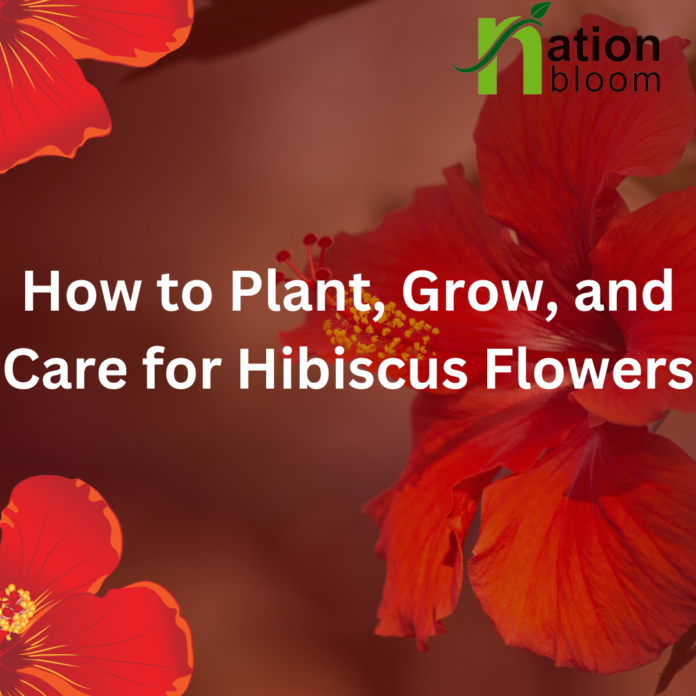Hibiscus flowers are a colorful addition to any garden, with their vibrant and showy blooms in shades of red, pink, yellow, and white. They are easy to grow and care for, and can be grown in a range of climates, making them a popular choice for gardeners all over the world. In this blog, we will cover everything you need to know about planting, growing, and caring for hibiscus flowers.
The Hibiscus plant comes in a wide variety of colors, including shades of red, pink, orange, yellow, white, peach and purple. Some hibiscus plants also have variegated or bi-colored flowers. Additionally, there are several categories or types of hibiscus plants, including tropical hibiscus, hardy hibiscus, and dwarf hibiscus. Tropical hibiscus plants are often grown as indoor or patio plants and are not frost-tolerant.
Hardy hibiscus plants are more cold-tolerant and can be grown outdoors in temperate climates. Dwarf hibiscus plants are smaller in size and are often used in containers or as border plants.
Choosing the Right Location for Planting Hibiscus:
The first step to growing healthy hibiscus flowers is to choose the right location. Hibiscus plants need plenty of sunshine to thrive, so it’s essential to find a spot in your garden that gets at least 6-8 hours of direct sunlight each day. They also prefer a warm and humid environment, so it’s important to keep them away from strong winds, and provide ample moisture.
Preparing the Soil for Planting Hibiscus:
Hibiscus flowers prefer well-draining soil that is rich in organic matter. Before planting, it’s a good idea to amend the soil with compost or other organic matter to improve drainage and fertility. A pH range of 6.0 to 7.5 is ideal for hibiscus plants. It’s also important to ensure that the soil is free of pests and diseases that could harm the plant.
Planting Hibiscus:
The best time to plant hibiscus flowers is in the spring or early summer when the soil has warmed up. Before planting, dig a hole that is twice as wide as the root ball and just as deep. Gently loosen the roots of the plant before placing it in the hole, and then fill in with soil, ensuring the plant is planted at the same level as it was in the pot. Water thoroughly after planting to help the plant settle in.
Watering Hibiscus:
Hibiscus plants need regular watering to thrive, especially during hot and dry weather. It’s important to keep the soil evenly moist, but not waterlogged, as hibiscus plants don’t like to sit in water. A good rule of thumb is to water deeply once a week, or more frequently if the soil is drying out quickly. Avoid getting water on the leaves and flowers, as this can lead to fungal diseases.
Fertilizing Hibiscus:
Hibiscus plants are heavy feeders and require regular fertilization to support their growth and blooming. A slow-release, balanced fertilizer with an N-P-K ratio of 10-10-10 or 20-20-20 is ideal for hibiscus flowers. Fertilize every 4-6 weeks during the growing season, but be careful not to over-fertilize, as this can lead to excessive foliage growth at the expense of flowers.
Pruning Hibiscus:
Regular pruning is important for keeping hibiscus plants healthy and promoting blooming. Prune in early spring before new growth appears to remove any dead or damaged branches, and to shape the plant. Pinch back the tips of new growth periodically to encourage bushier growth and more blooms.
Protecting Hibiscus from Pests and Diseases:
Hibiscus flowers are susceptible to a range of pests and diseases, including aphids, whiteflies, spider mites, and powdery mildew. Regular inspection and monitoring of the plant can help prevent and control these issues. Use insecticidal soap or neem oil to treat pests and a fungicide for fungal diseases. It’s also important to keep the plant well-ventilated and avoid overcrowding to prevent fungal issues.
In conclusion, growing and caring for hibiscus flowers is a rewarding experience that can bring vibrant and colorful blooms to any garden. To successfully grow hibiscus, it’s important to choose the right location with adequate sunlight and well-draining soil, to water and fertilize regularly, and to prune and protect the plant from pests and diseases. With proper care, hibiscus plants can thrive and provide a beautiful display of color and foliage for years to come. Whether you choose a tropical, hardy, or dwarf variety, hibiscus is a versatile and beautiful addition to any garden.
Explore Our latest blogs
No More Mistakes With Succulent Plants
How To Make More Grow Plants By Doing Less
Low-maintenance seasonal plants in India














